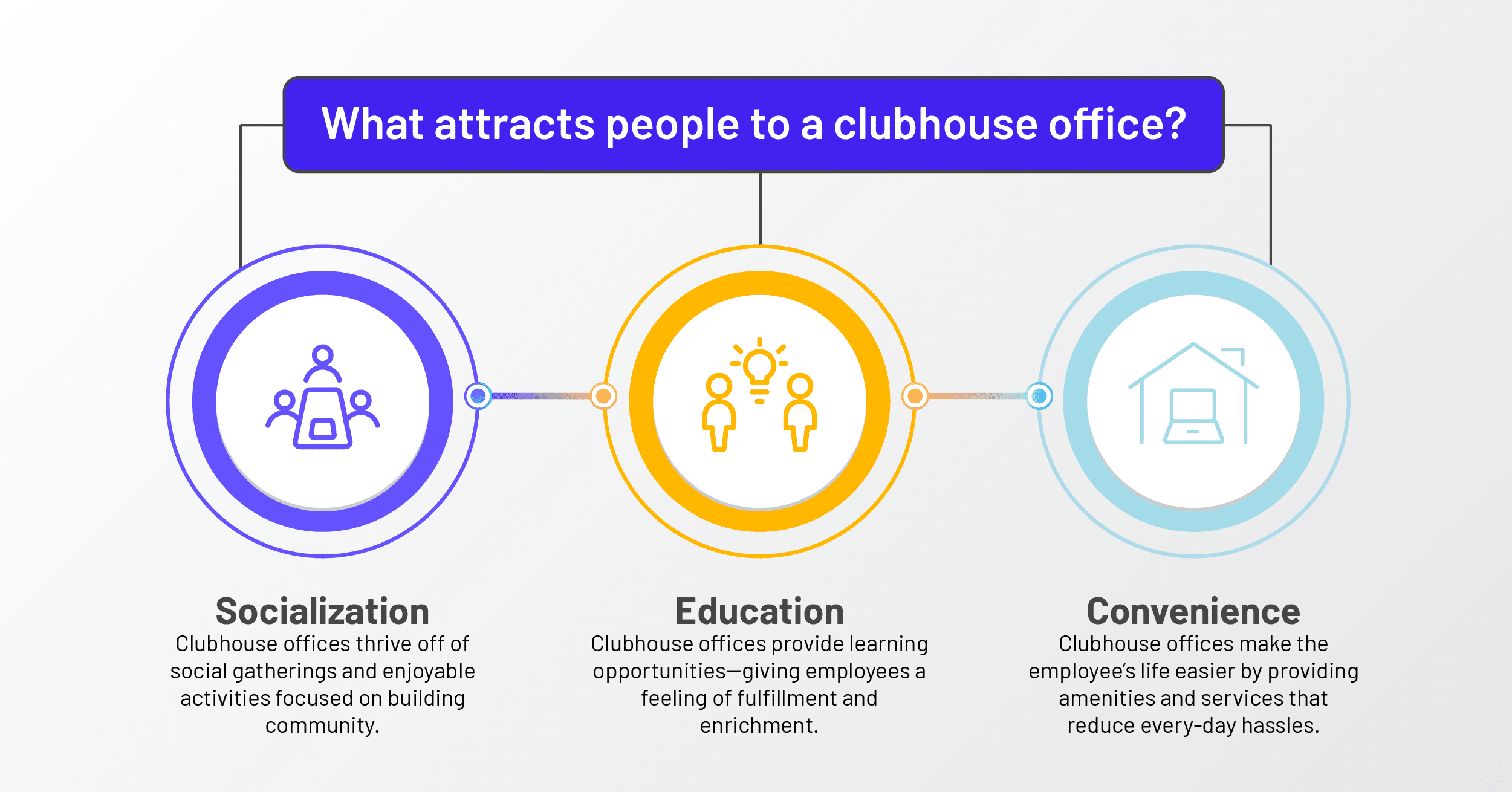Clubhouse offices completely lend themselves to fostering human connection and may be a great way to attract people back into the office.
To incentivize employees to come back into the office, many advocate that offices should be flipped into more “clubhouse”-style workspaces.
Before the pandemic, these types of progressive workspaces were typically found at places like WeWork and Industrious. Offices that are epicenters of employee culture, connection, and community. Clubhouse offices flipped the script in terms of office functionality by embracing the idea that experience-based interactions should drive office engagement and attendance, rather than task-based work paired with rigid attendance policies.
Workplace innovators have long predicted that offices were already moving this way. To many, Covid merely accelerated the “clubhouse” office movement. Covid revealed the flaws in rigid workplace strategies and shed light on the importance of the whole employee experience and lifecycle.
Put yourself in the employee’s shoes
In a past life, employees went to an office, Monday through Friday, by default. Excluding the weekend, their work week revolved around getting to and from work, all while balancing their personal life.
Think about everything they did in between going to the office—errands, socializing, exercising, etc.—and ask yourself:
What of those “in-betweens” can be folded into the office? What activities, amenities, and/or services could be offered at our office, to keep people engaged with it?
Offering an engaging office experience is what a clubhouse office is all about. It’s to fold work—and most importantly, not work—into one space where people want to be. There are a lot of reasons to pursue a clubhouse office but bear in mind that they must reflect actual employee needs and demands. While things like free tap beverages have long been elements of such spaces, they are mere accents of greater strategic discussions that must be had in order to execute such an office.

Generally speaking, these three reasons get people out of the house and back to the office:
Reason #1: Socialization
The first—and most obvious—way to fold these in-between moments is to have offer spaces that seamlessly enable social interaction. From team building to larger office events, making the office the epicenter for socialization is perceived as a good reason to not work from home, for many people.
It’s why we see a lot of hospitality-inspired social spaces at modern offices. If the main social area has a variety of settings to gather, and the space itself has a trendy cocktail/coffee bar vibe, people are bound to connect with teammates and friends.
During my time at WeWork, Friday afternoons kicked off the weekends with a company happy hour. By the early evening the HQ was buzzing with employees, their friends and friends of friends; meeting, catching up, playing games—but most importantly—building culture in the office. We called this space “the center of gravity” for a reason. Guests to the space would rave about it and express their desires to work in such a space or for such a company.
The purpose behind this spatial design and activation is to lend itself completely to human connection.
Similarly, a large multi-purpose, function-style room can be configured on the fly to host events that simply break up the work day/week. Sporting events, watch parties, game nights, etc.—many office spaces can be flipped to better accommodate enjoyable, non-work related group activities.
Reason #2: Education
Clubhouse style offices that have spaces for education and professional development are becoming increasingly more in demand by younger employees.
As recently noted by Google, “5% more employees are returning to offices week after week.” Among these employees are predominantly Gen Z’ers who have a strong desire to learn from co-workers face-to-face. From in-person town halls and “lunch and learns,” to transparent “ask me anything” sessions with executives—an office that provides people a place to learn about their company, hone their skills, and develop professionally have long been a way to draw people in.
Along with these org-centric gatherings, host external SMEs and recreational activities like a cooking or cocktail making class. People like to learn because it gives a feeling of fulfillment and enrichment—associate the office with these types of rich experiences. This keeps them not just in an office but at a company.
Reason #3: Convenience
One of the most coveted reasons why many people love working from home is convenience. It’s convenient to not have to factor in a commute amidst the busy lives everyone has, outside of work. When you have control over your time, running that quick errand to the dry cleaners and getting that long overdue haircut, mid-day, is no big deal.
Those errands do however “pile up” when they have to be done amidst commuting to and from the office. What if the office provided access to services that make coming into the office as convenient as working from home? What if your office had amenities?
- Self-care amenities: From fitness classes to pop-up barber shops, multi-purpose spaces that can house or rotate activities for self-care, health, and wellness, eliminates an extra step in the day—and cost—for those who value such things.
- Every-day-errand amenities: Find a local dry-cleaner, and facilitate a regular laundry drop-off/pick-up service at the office. Have a local coffee shop set up a few times a week so people don’t feel like they need to go get coffee. Many local businesses are looking for new ways to adapt to the changes brought on by Covid—find local vendors who could benefit from making your employees’ lives more convenient.
- Family-centered amenities: If you’re dealing with an enterprise-sized real estate portfolio, chances are you have a lot of wasted space—it’s estimated that office space sits empty and idle 50% of time. Redesign parts of your office to provide child care, new mother rooms, etc. If you don’t want to downsize space, and want to provide useful services to those who are parents, make their lives easier and redesign unoptimized spaces to facilitate family-centered amenities.
Covid revealed that commuting to and from rigid working arrangements was unnecessary and most of all, inconvenient to people’s everyday lives. By building convenient amenities into offices, you’re both enhancing the employee experience and incentivizing office engagement.
Start small and experiment
The business expectation that we must “get it right” the first time is no longer conducive to reimagining office space. No company can do this all at once and they shouldn’t try—developing a clubhouse requires experimentation and a lot of data about people and space to successfully execute.
Instead of over-indexing, start with incremental changes, analyze how they performed, and build from there. Be patient, try new things, listen to your employees, and keep your workplace strategy flexible by learning what exactly your employees want to come in for.
Who benefits from a clubhouse office?
Simply put, employees and employers both benefit from clubhouse offices.
At a base level, clubhouse offices provide employees with community, pride in one’s work, and enjoyable spaces to be. Most of all however, they provide flexibility—the main driver of why employees choose to work or not work at an employer.
Whether or not you provide a robust offering of amenities and/or services, depends on what’s feasible, realistic, and of interest to your employees. By just starting with comfortable social areas, you’re showing your employees that their company cares about their presence—that you care about evolving your company culture to be more human-centric.
In return, employers earn employee loyalty in a fiercely competitive and talent-centric job market.
How do I figure out what my people want?
With any office redesign, a multitude of data points have to be considered. From employee surveys to smart sensors that track how space is actually being used–in order to thoughtfully design space, a ton of data has to be collected and analyzed to inform space planning.
To learn more about the intersection of people, data, and space, check out our on demand webinar featuring Jay West (JLL) and Hannah Kumlin (JLL) for best practices on how to capture, analyze, and act on workplace data. In this Saltmine moderated conversation, Jay and Hannah share their mutual passion of leveraging data to create a better employee experience, as well as how to get the best ROI on office space.
Click the image below for the on demand webinar:
Enjoying our blog? Be sure to subscribe to stay up-to-date on Saltmine's original content with the form below!

 by
by 
